Mount Kilimanjaro has a problem: acclimatisation. The old adage to avoid acute mountain sickness is that you should climb high, then sleep low. That’s not an issue in a peak-packed mountain range where you can climb to a pass, drop to a camp to sleep, then climb again the next day.
But Kilimanjaro is the highest freestanding mountain in the world (and arguably one of the world's best hikes), with the climb starting at its base and finishing at its summit. Some routes take a circuitous approach, climbing, traversing, dropping slightly, and climbing once more on the journey to the summit. The more days this is spread over, the higher the chances of success.
Kilimanjaro has another problem: popularity. The world, its neighbour and their favourite talent show pop group have climbed Kilimanjaro. There’s nothing wrong with that – it’s a magnificent challenge and fair play to all who take it on via one of its more straightforward approaches.
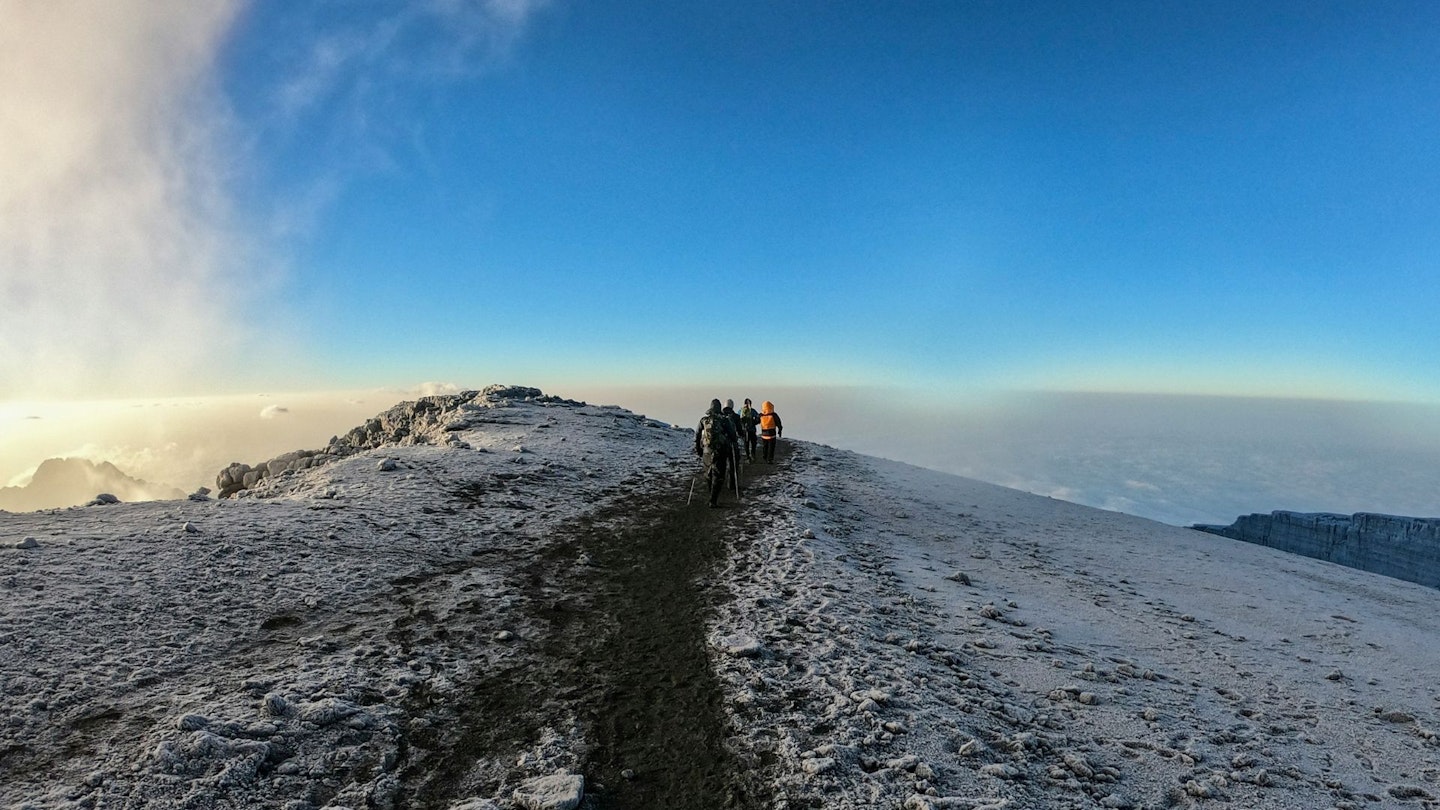
But if you’re serious about your mountains, then you’ll probably crave the most ambitious route to its summit. Enter the Western Breach. A lavaformed gap in the crater rim of Kibo, Kilimanjaro’s main cone, it's regarded as the most challenging route to the top that doesn’t require ropes.
Only a handful of guiding companies offer it and Sheffield-based Jagged Globe is one of them, with an itinerary that also provides an acclimatisation ascent of nearby Mount Meru.
With visas stamped, inoculations jabbed and a bulging duffel bag, I set out for the roof of Africa on a trip of a lifetime to Tanzania…
Day 1: Arrival in Africa
I can just make out the shadow of Kilimanjaro in the night as we’re driven in a safari-style 4x4 to our hotel. The journey to Moshi is an opportunity to get to know the group. Barry and Steve are retired tax inspectors (a career with an unlikely pedigree in mountaineering). Barry has climbed all over the world, while this is Steve’s first big mountain trip.
Magda is a Polish marathon-runner from Carlisle who's brimming with enthusiasm. Team leader Andy Chapman has been above 5,000m over 100 times, including Everest (which has its fair share of challenges for climbers), so we’re in good hands.
At the hotel he briefs us on what to expect tomorrow when we head to Mount Meru for the first leg of our African adventure.
Day 2: Wildlife safari
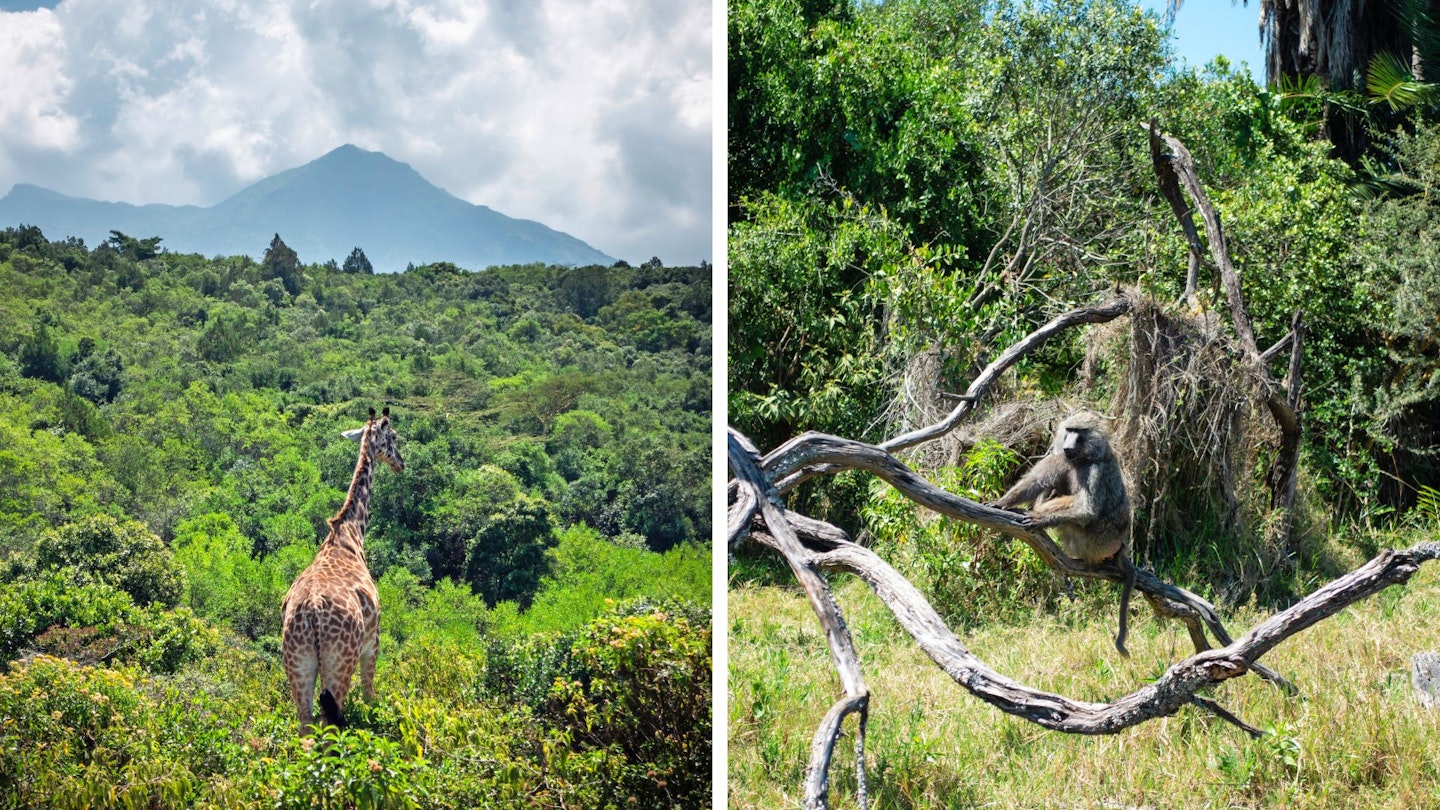
The drive to the start of the trek is an adventure in itself. Baboons move lazily among the trees, zebras graze on the plains and warthogs linger near the water’s edge.
Once on foot we’re accompanied by a ranger – a serious man dressed in military green and carrying an equally serious-looking rifle. I point at his gun. “That looks like it could stop a buffalo! What’s it for?” “Stopping buffalo,” he replies. Shot one apparently goes in the air to scare them off. If that fails, shot two is more direct.
We spot a giraffe’s neck sticking above the scrub, then more. About a dozen in total. Trekking higher the guides point out birds, berries, footprints and leopard dung. It takes four hours through the forest with glimpses of colobus and blue monkeys to reach Miriakamba Hut, a collection of low buildings with squat-and-drop toilets, and our overnight base at 2,514m.
Someone calls out. “I can see Kilimanjaro!” All I see is cloud. Then I realise my mistake. I’m looking too low. The summit is poking out above the cloud. Christ, it’s huge.
Day 3: Mission to Meru
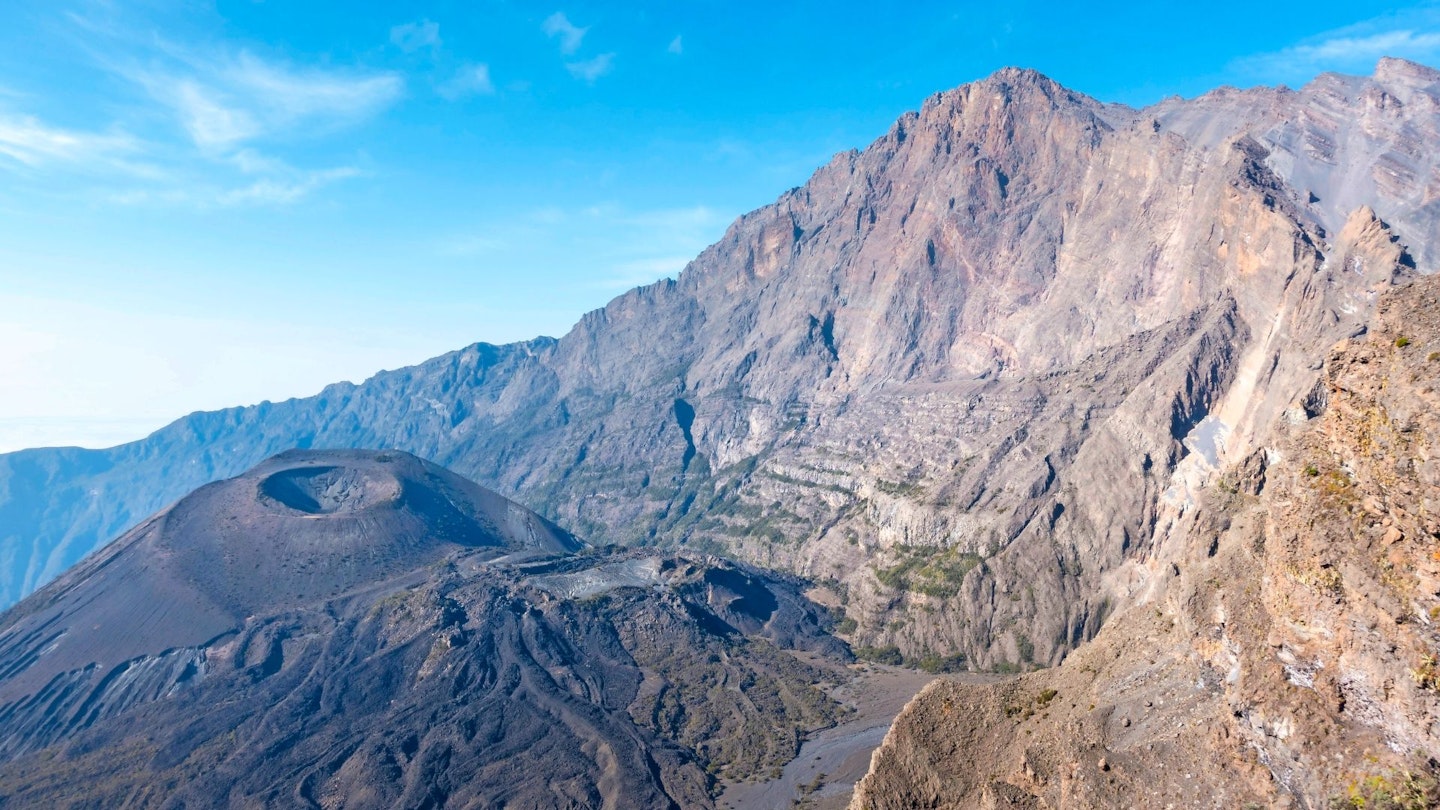
The trees give way to giant heather as we climb. Huge ravens soar overhead and our ranger points out a column of fire ants, explaining that their bite is painful and that they can swarm up the leg of your walking trousers with frightening speed.
We arrive at the 3,566m Saddle Hut around midday, snack quickly and set off on a dusty climb to the subsidiary top of Little Meru as a leg and lung stretcher. From the 3,820m summit the views of Big Meru are exceptional, the parent peak looking every bit the dormant volcano it is. But Kilimanjaro is hiding.
Day 4: Magical views
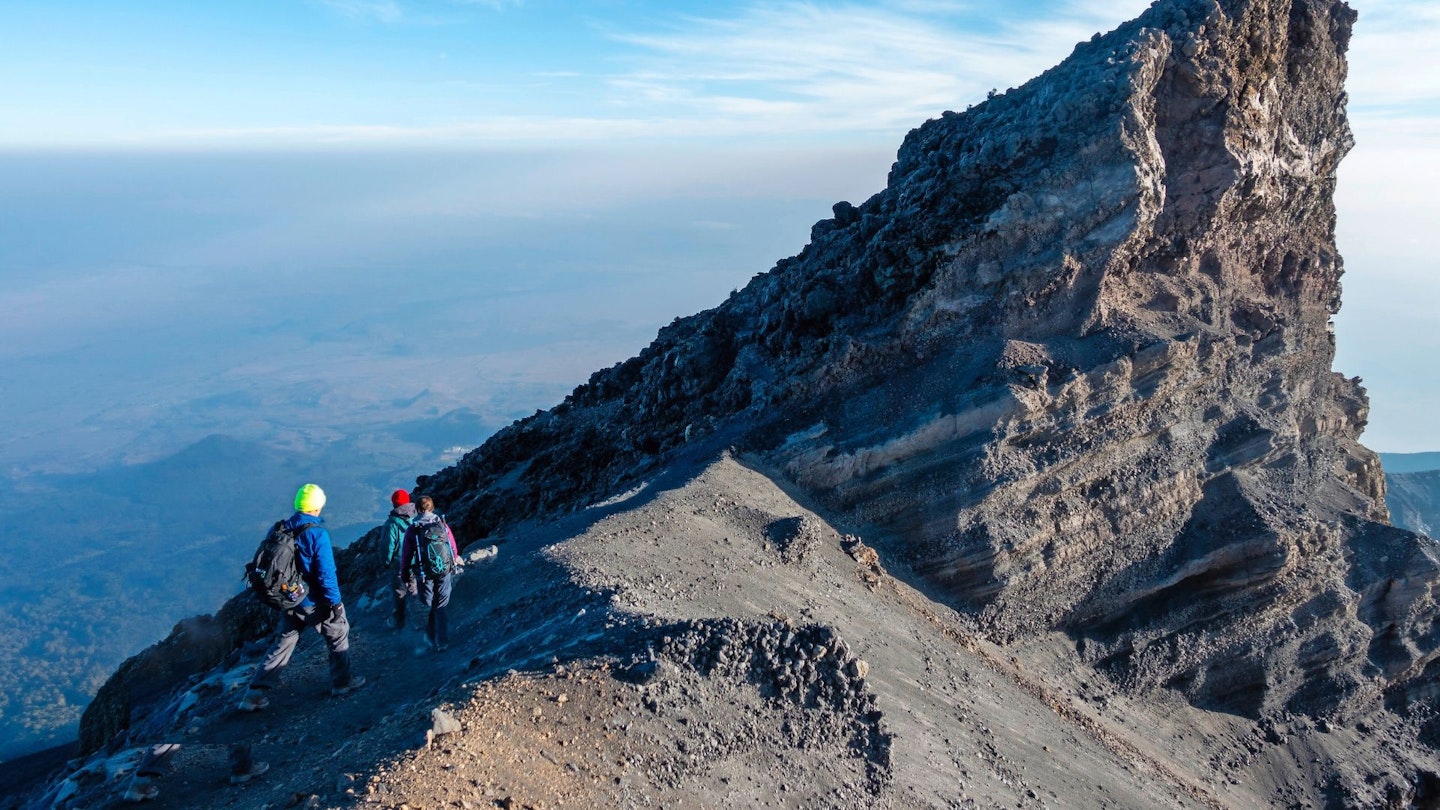
It’s midnight. I’ve had less than two hours sleep, but I’m fuelled by excitement. We gobble down porridge and head out into the moonlit night with local guides Clemence and Habat, and porter-cum-guide Daima.
Our first objective is Rhino Point at 3,800m, a small horn of mountain completely devoid of rhinos. A slight chain-aided descent is tackled before we climb again. Barry hasn’t been sleeping well – a result of his antimalarial medication – and opts to turn back.
The track becomes fine volcanic ash, sliding down with every footstep. Steve too is struggling and Daima takes his rucksack. Sunrise is a way off and the temperature drops as we climb. Below, the lights of Arusha sparkle in the blackness, mirroring the stars.
"Pole pole" (slowly slowly) is a phrase frequently repeated by the guides. It’s the only way to climb big mountains. I begin to notice the effects of altitude around 4,200m. Slight nausea, a hint of a headache. I take long deep breaths, exhaling rapidly after each. My balance is off and the terrain is hard. I ask Magda if she’s feeling any effects from the altitude. She says no. I swear at her.
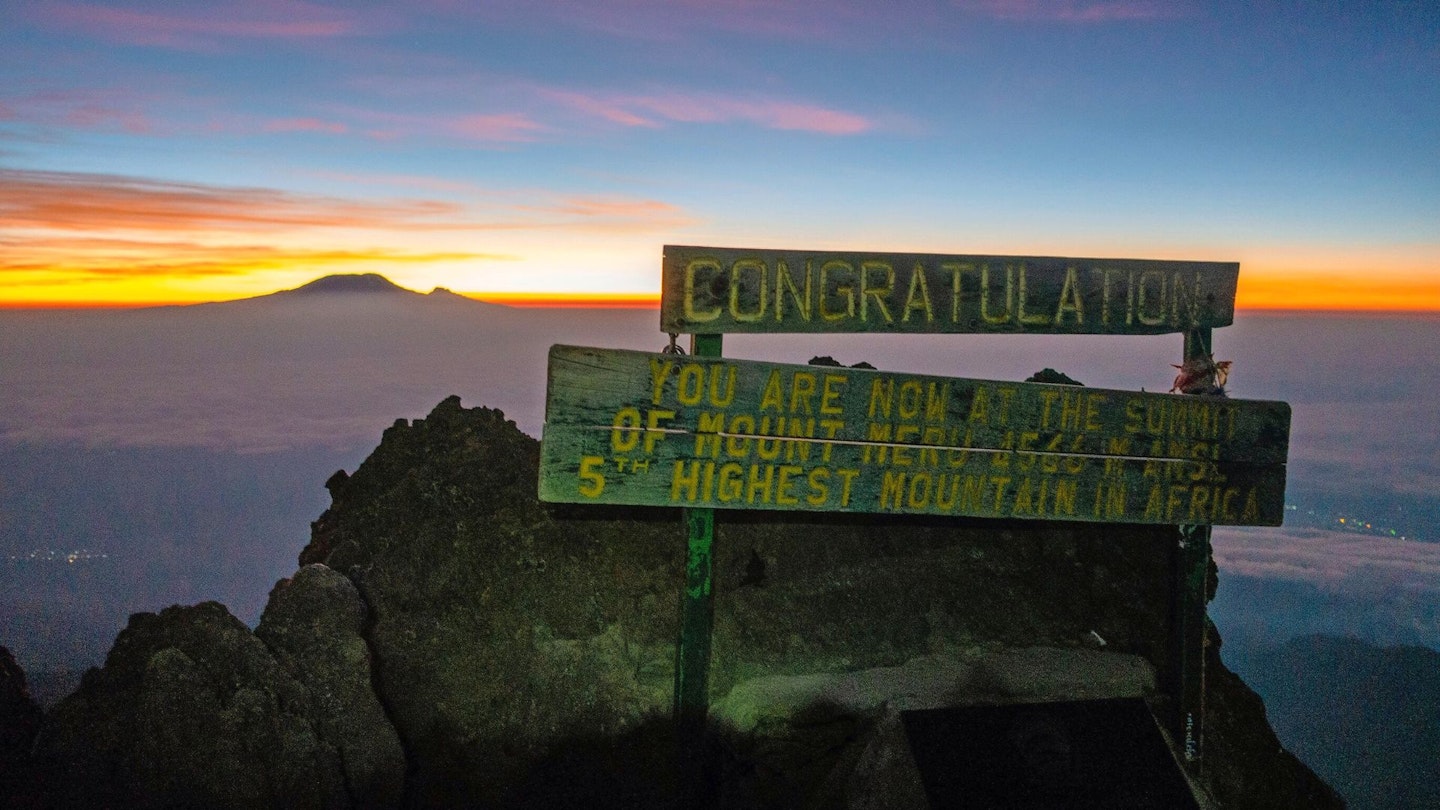
It’s 6am as we gather around Meru’s rustic summit marker for hugs and photos. Then something happens. It begins as a line of brightness across the eastern horizon, growing, becoming richer in hue, filling the sky behind a mountain-shaped silhouette – Kilimanjaro.
The crescendo of colour builds until, in a spectacular eruption, the sun crests the horizon; not above Kilimanjaro, but at its feet. It’s not a view so much as an awakening. Once again I’m staggered by just how big that mountain is.
The returning daylight reveals all the details of Meru that were hidden by the night. Our route curves around the crater rim, in the middle of which stands a huge ash cone. The soft substrate that had sapped energy in ascent is a joy to plunge down, and it takes little over three hours to reach Saddle Hut. It’s 9.30am. The rest of the camp are just getting up.
Day 5: Wild water
A return down our ascent route takes us back through the forest until we’re led away from the main track on an unexpected detour. We pass through trees on a hillside with giraffes and zebras on the plains below to emerge in a steep-sided ravine with a spectacular waterfall at its head. I’m hot, dusty, and quickly into the water.
The torrent is fresh, cold and much stronger than it looks. The African sun dries my clothes by the time we’re back at the gate. There's more paperwork to be completed before we depart for the hotel. Kilimanjaro starts tomorrow.
Day 6: Forest in the sky
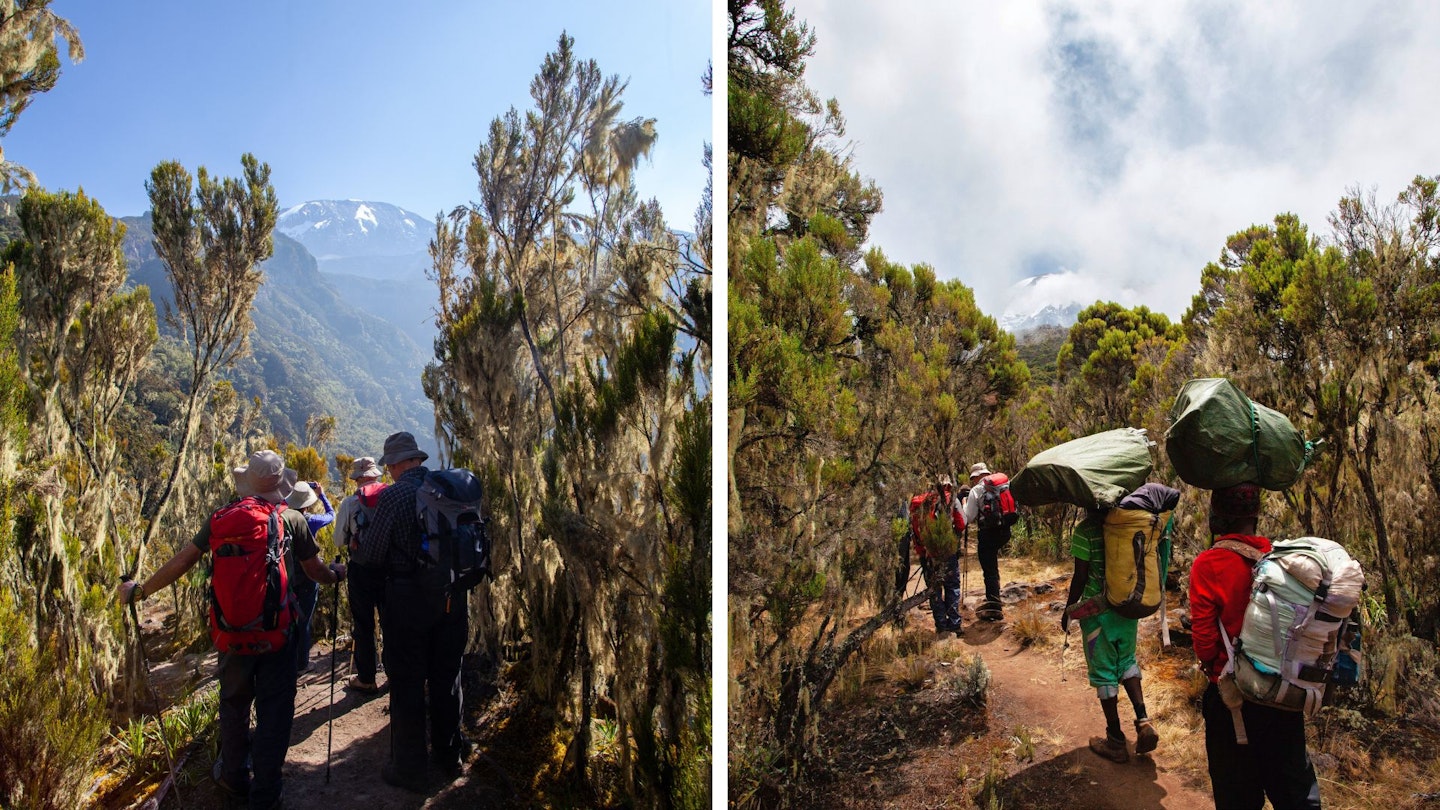
We bounce along a dusty road lined with low buildings and waving children to Umbwe Gate. As we wait to enter the national park (the Tanzanians love paperwork) the team of porters arrive.
As well as the bulk of our overnight gear they’ll also be carrying the tents plus all the food and kitchen equipment. They’re absolute legends, always greeting us with a cheery "jambo". Daima leads the way. On his back is his rucksack. On his head is 20kg of camp gear.
The canopy of the jungle offers shade, but it’s humid. The forest thickens as we climb, twisted trees dripping with moss of every shade of green. It soon becomes clear we’re ascending a forested ridge flanked by river-bottomed valleys.
An ascent almost equivalent to that of Ben Nevis eventually brings us to the Umbwe Cave Camp – a series of forest clearings terraced over different levels. Despite being nearly 3,000m up there’s no sense of being on a mountain.
The porters are already constructing our camp: three two-person tents, a mess tent for dining, a kitchen tent and a yellow phone-box shaped tent Barry christens ‘Big Potty’. No prizes for guessing what’s in there.
Day 7: Glorious views
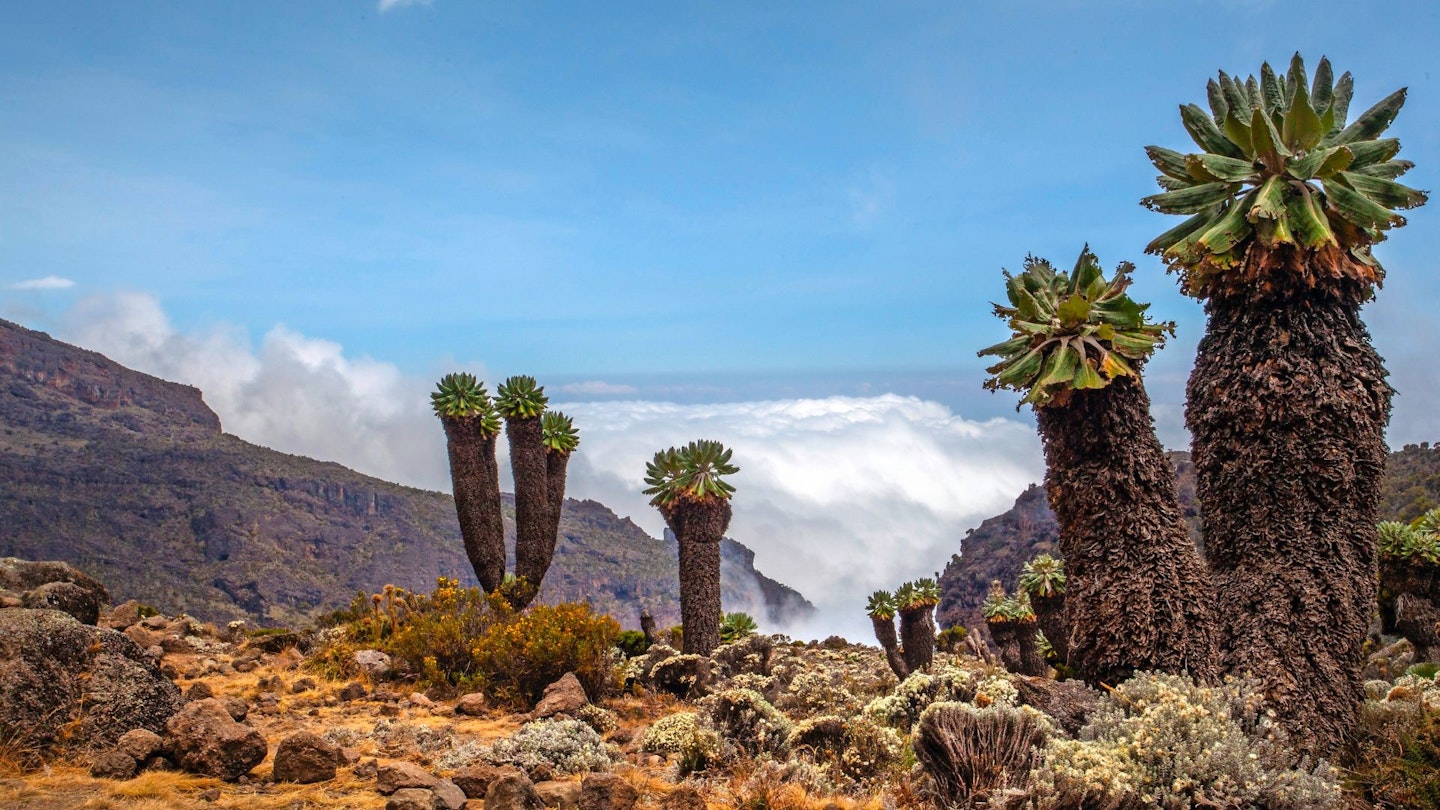
The vegetation changes soon after leaving camp, with dense forest replaced by giant heather draped in moss. Here we get our first clear views of Kilimanjaro since stepping foot on it.
Andy points out the Breach Wall (through which our passage to the summit will thread), the Messner icicles (spindly looking fingers of ice which Reinhold Messner once climbed) and the Southern Icefield including the Decken Glacier, Kirsten Glacier and the Heim Glacier (which is almost gone).
At a busy Barranco Camp later that evening, as dusk settles, a pea-soup mist sweeps in and we retreat to the mess tent for food and conversation.
A little later a voice calls from beyond the canvas: “It’s clearing!” I rush outside. The mountain towers into the starry sky, with the high white glaciers matching the pale streak of the Milky Way above. It is glorious.
Day 8: Rest day
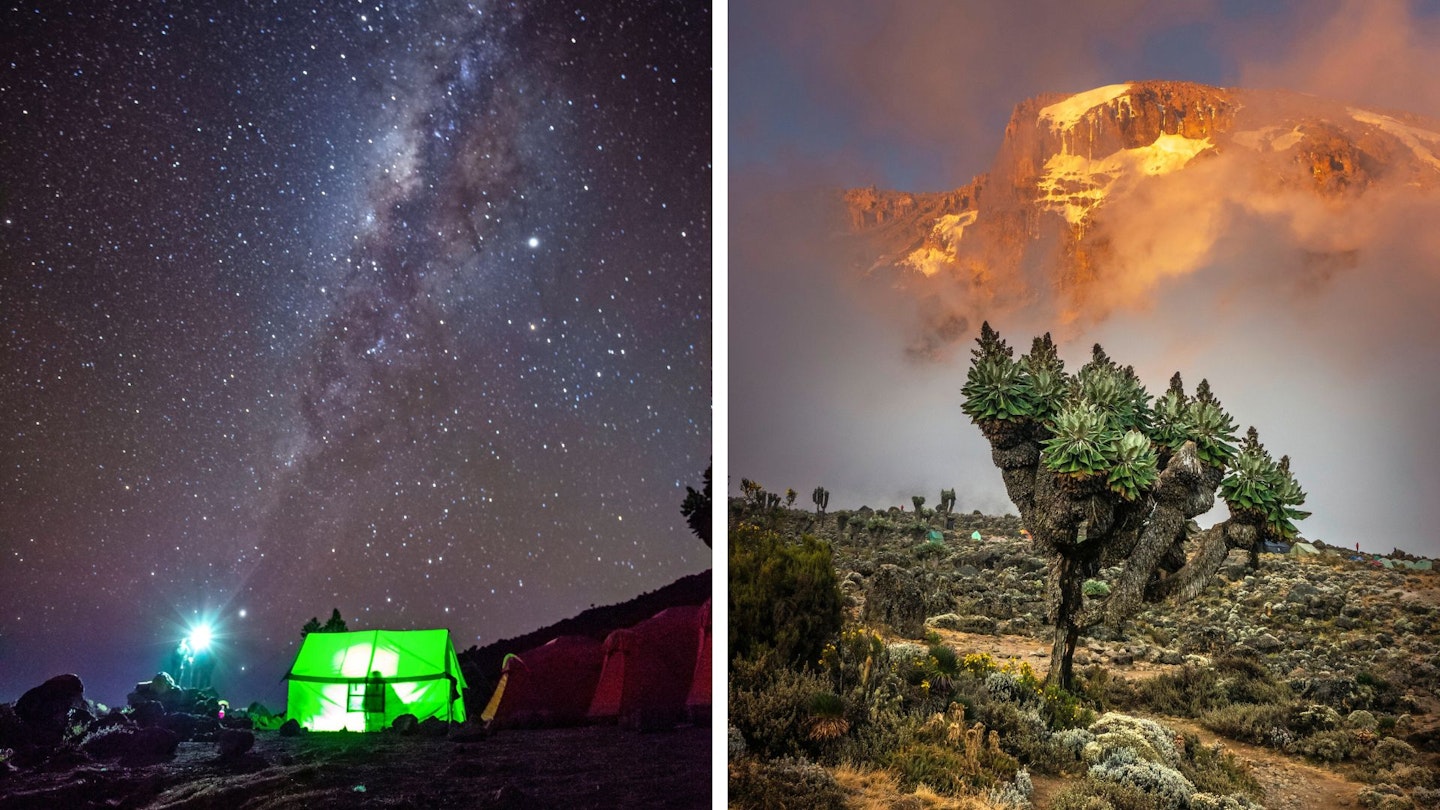
Singing drifts across the camp; porters serenading the departing masses trekking up the Barranco Wall. For us today is a rest day, but we need to get our hearts going to aid acclimatisation. We opt for an easy ascent to a radio tower some 200m above Barranco, the short trek breaking the 4,000m contour and giving us views back to Mount Meru.
Coming down we pass a levelled area with a large ‘H’ marked out with rocks. Guides mill about, with one speaking intensely into a phone. A pale walker sits on a rock with his pack at his feet. We arrive back at camp as a helicopter flies in to evacuate the man who was suffering from the effects of altitude and hypothermia. This is a serious mountain.
Day 9: High camp
Barranco Camp is the dustiest place I’ve ever been, but as we climb the dirt begins to give way to rock, the vegetation all but disappears and the temperature plummets. I start to feel a little lightheaded at 4,425m – exactly half the height of Everest. We pass a lone leather boot among the rocks and as we ascend into thicker clag, fine snow begins to fall.
Arrow Glacier Camp feels like a proper high mountain camp, surrounded by strange shaped volcanic outcrops. The dusting of snow continues for much of the afternoon. We gather in the mess tent for a final briefing. We’ll be making a midnight departure and carrying ice axes, but the Western Breach is on.
Day 10: Summit push

It’s a cold, sleepless night. By 12am we’re up, dressed and trying to eat. Barry has never quite recovered from his illness and has made the difficult decision not to summit. We hug our farewells and head out into the dark with head torches strapped to our helmets.
In 2006 three people were killed by rockfall in the Western Breach. In 2015 another trekker was killed by a falling boulder. We pass a wooden painted post exclaiming "ROCK-FALL CORRIDOR, KEEP MOVING". No arguments here.
The going is deliberately slow. "Pole pole". It’s pitch black beyond the torchlight and bitingly cold. My nose numbs as I gasp in thin air. The going becomes more akin to scrambling. It’s no worse than anything on Tryfan in Snowdonia – but we’re at 5,400m, climbing by torchlight, and I’m wearing thick mitts.
A series of rock steps provides the greatest challenge. I’m breathing hard by the top of them. Up ahead, above the mountain, the sky is brightening. We break onto the crater rim as the sun hits it, returning warmth and colour to the world.
Climbers on the Western Breach used to cross glaciers to the summit. Andy did so back in 1989. It was the daily warming of the Arrow Glacier that released rocks down the Western Breach. That glacier no longer exists.
While still present, the Furtwängler Glacier is a mere fragment of what it once was a few decades ago, and although the vast whiteness of the Northern Icefields looks impenetrable, even their future is uncertain.
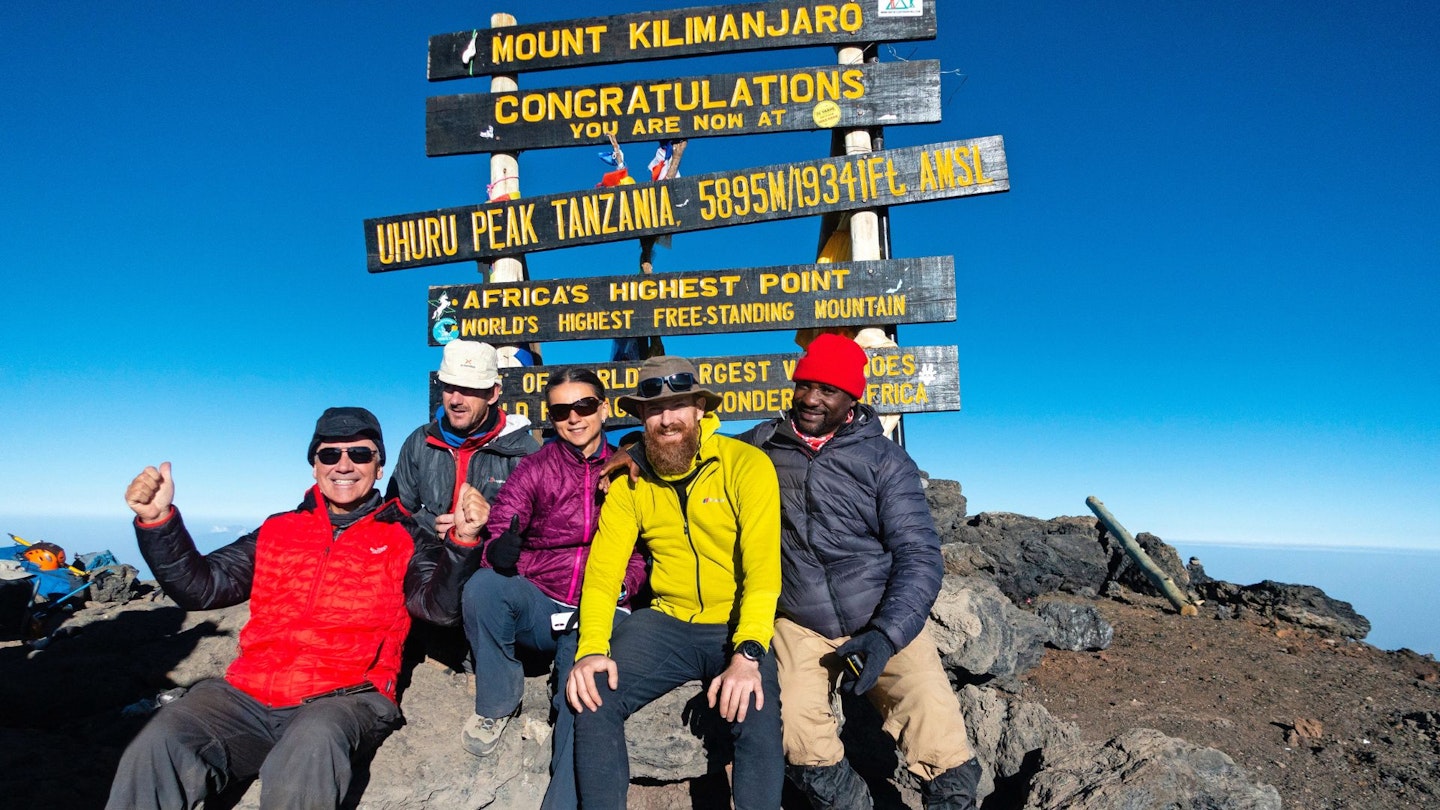
I dig deep for the last ascent up to the summit ridge. My tank is empty but an energy gel is all I can stomach. I’m exhausted and heavy legged, but it’s almost done.
In the distance, a small rise in the ground topped by a familiar wooden sign marks Uhuru Peak and the 5,895m summit of Kilimanjaro. I take in the surroundings, the sweep of the southern glaciers, the vast crater and what feels like all of Africa laid out below.
I’m light-headed again, but I don’t know if it’s altitude or emotion. The summit is busy. Everyone hugs. Magda does burpees. We gather our breath and thoughts, suck up the air and the view, and start our descent, heel-plunging through the loose stones of a dusty scree slope.
Overlooked by Kilimanjaro’s eastern cone, Mawenzi, we pass through Barafu Camp (where many summiteers begin their day) and head onwards to Millennium Camp. In the past 10.5 hours we’ve climbed over 1,000m, descended nearly 2,000m, and stood on the roof of a continent. We find a patch of grass beneath a tree, lay on our packs, and sleep. It’s 11.30am.
Day 11: Reflections
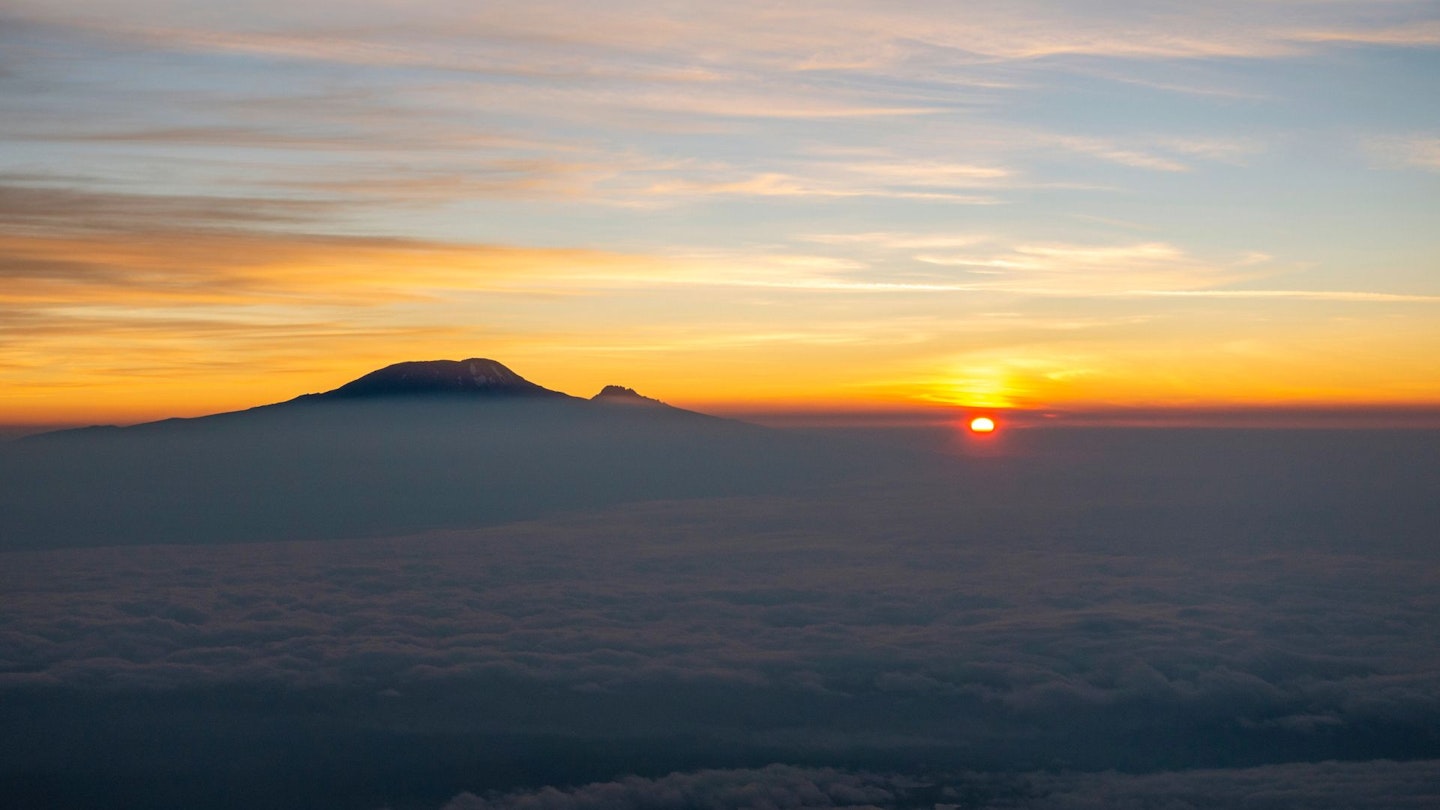
Somewhere on the descent to Miweka Gate, through a gap in the forest canopy, I get my last view of Kilimanjaro. I know at the gate there will be more form filling. Later tonight I’ll be on a plane bound for the UK. I don’t want to think about that. I’m still in a mountain headspace.
Instead I think about Mount Meru, about giraffes, about the ranger with his gun, about the sunrise, about the porters and guides, about my teammates, my friends. I think about the harshness of the mountain nights and the warmth of the mess-tent mealtimes.
And I think about standing on the summit of Africa. I realise that this feeling will never go completely, it’ll always be with me. I’d heard Africa gets you like that. It’s true. Hurry boy, it’s waiting there for you…
About the author
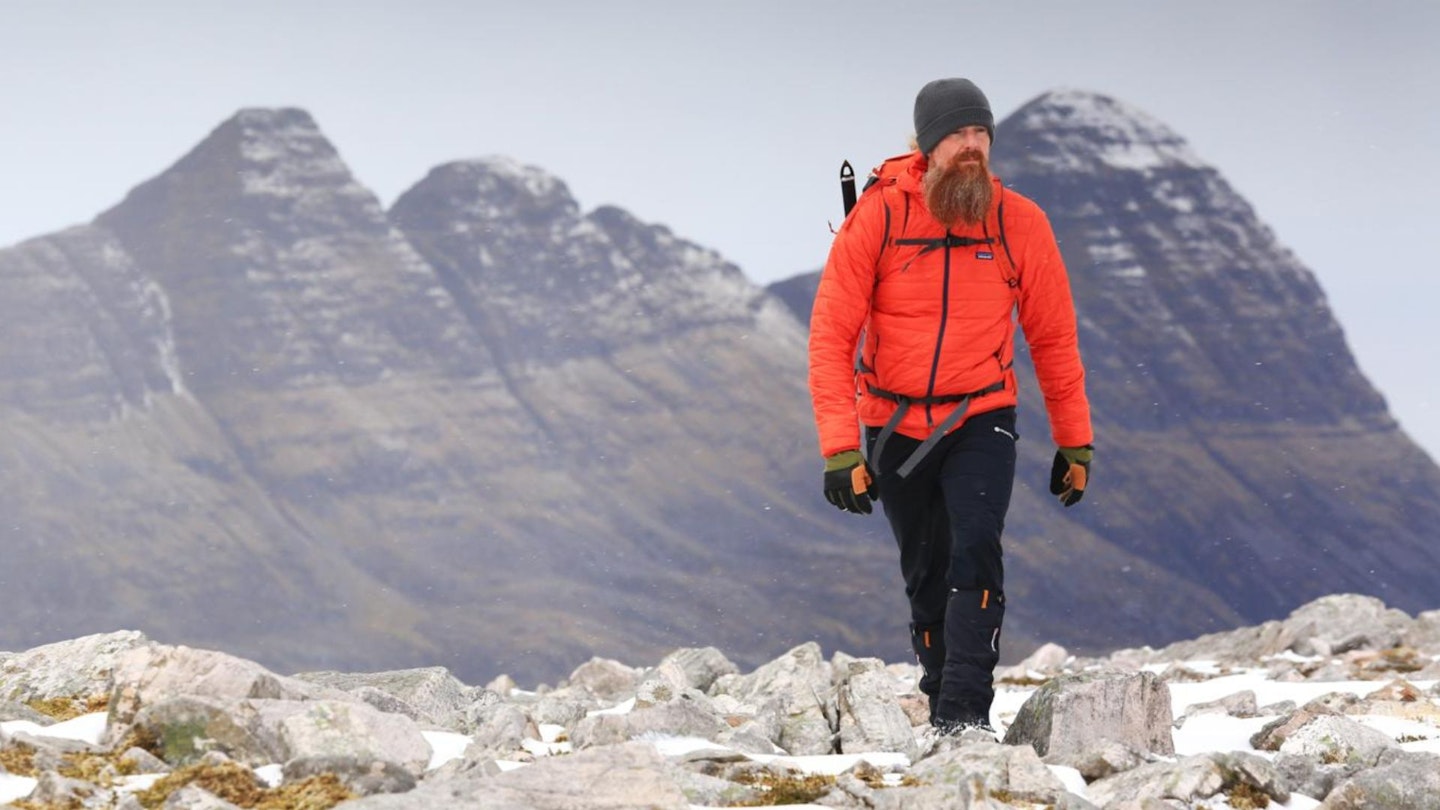
Ben Weeks has been with LFTO's sister title, Trail magazine, for over 10 years and is our main point of contact for all gear reviews. As well as being a hugely talented writer and photographer, Ben is also a qualified mountain leader and climbing instructor.
